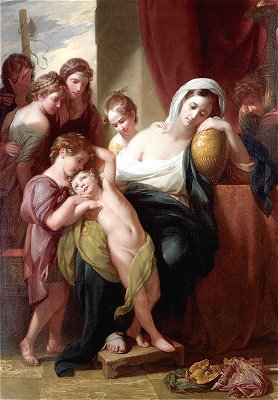 |
|
Agrippina and her children mourning over the ashes of
Germanicus.
by Benjamin West, American 1738-1820
CN 403 Oil on Canvas 1773
By Robert Anderson
Artist:
Benjamin West was a renowned American artist who after a brief career as a portrait
painter in Philadelphia and New York went to Italy in 1760 seeking further training. While
in Italy he was influenced by the Englishman Gavin Hamilton and the German Anton Mengs and
developed a neo-classical style. West then made his home in London in 1763 and in spite of
(or because of) being an American became an instant success as a portraitist.
In 1768 he became a founding member of the Royal Academy and in 1792
succeeded Sir Joshua Reynolds as its President, a position he held for the next
twenty-eight years.
In 1770 he painted his famous history painting, The Death of General
Wolfe, in which the figures are seen in contemporary dress. This was a departure from
tradition in historical scenes which was soon followed by other artists. Shortly
thereafter, in 1772, he was named historical painter to King George III.who had become an
admirer of West's work. It is interesting to note that he kept the favor of the King in
spite of his outspoken expressions of sympathy for the American cause during the American
Revolution. |
West was in the vanguard of the Romantic Movement and has been hailed as a
forerunner of Delacroix. His historical importance, however, outweighs the quality of his
work. He was the first American painter to gain an international reputation and he became
the prototype of the expatriate artist. He is generally recognized as a stylistic
innovator of immense influence who first attempted to bring American art into congruity
with European art.
Subject:
Germanicus was the nephew and adopted son of Emperor Tiberius Caesar. As a Roman general,
Germanicus won a number of victories in Germany and wished to continue with his aggressive
warfare. Tiberius disagreed and reassigned Germanicus to the East where he took sick and
died in Antioch. All of Rome suspected that Tiberius had had Germanicus poisened.
Agrippina, Germanisus' wife returned to Rome with her three sons.
Agrippina subsequently plotted and planned for her son, Nero, to replace
or succeed Tiberius as Emperor. She and two of her sons were then banished from Rome and
were shortly thereafter executed on Tiberius' orders. Her third son, Gaius (identified in
the painting as the smiling boy in the foreground) was to become the notoriously cruel
Emperor Caligula (12-41).
Painting:
This painting is a fine example of what has been called West's Stately Mode. It uses a
monumental scale to elevate the subject from a sentimental episode to a moral statement.
Agrippina can be regarded as a secularized Madonna - the religious overtones are
deliberate as was made clear in a preliminary drawing which treats the subject as a
variation on the Virgin and Child with the Infant St. John.
This masterpiece shows the neo-classical influence that Italian art had
exerted on West during his years in Rome. It was exhibited at the Royal Academy, London in
1773, the same year in which it was painted.
The painting is related to a previous painting, Agrippina Landing at
Brundisium with the Ashes of Germanicus, which he had painted for King George III. The
story of this military hero who died in the service of his country and the stoic grief of
his wife who had accompanied him everywhere was seen as a noble example by the
Enlightenment, as against the hedonism of the rococo.
Historical Context:
West was active in England during the American Revolution and later during Eng land's wars
with Napoleon. He was an outspoken advocate of American liberty and in later years favored
the French under Napoleon. After a visit to Paris in 1802, during which he met both
Napoleon and David, he lost the favor and patronage of King George. He continued, however,
to be both a popular and successful painter until his death in 1820. |
